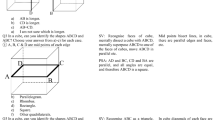Abstract
This study presents evidence which suggests that students in grades 5 through 8 have difficulty relating isometric type drawings to the rectangular solids they represent. Items of the sort “How many cubes does it take to build a given (pictorially presented) rectangular solid” were used. The errors made by students were analyzed and the effect of instruction in spatial visualization activities on the performance of middle school students was assessed. The findings were examined relative to their practical teaching implications.
Similar content being viewed by others
References
Bishop, A. J.: 1979, ‘Visualizing and mathematics in a pre-technological culture’, Educational Studies in Mathematics 10, 135–146.
Bishop, A. J.: 1980, ‘Spatial abilities and mathematics education—a review’, Educational Studies in Mathematics 11, 257–269.
Blade, M. and Watson, W. S.: 1955, ‘Increase in spatial visualization test scores during engineering study’, Psychological Monographs 69, no. 12.
Brinkmann, E. H.: 1966, ‘Programmed instruction as a technique for improving spatial visualization’, Journal of Applied Psychology 50, 179–184.
Bruner, J. S.: 1973, Beyond the Information Given, Allen and Unwin, London.
Connors, J. M., Serbin, L. A., and Schackman, M.: 1977, ‘Sex differences in children's response to training on a visual spatial test’, Developmental Psychology 13(3), 29304.
Connors, J. M., Schakman, M., and Serbin, L. A.: 1978, ‘Sex-related differences in response to practice on a visual-spatial test and generalization to a related test’, Child Development 49, 24–29.
Cox, M. V.: 1978, ‘Perspective ability: a training program’, Journal of Educational Research 71(3), 127–133.
Eliot, J., and Fralley, J. S.: 1976, ‘Sex differences in spatial ability’, Young Children 31, 487–498.
Fennema, E.: 1975, ‘Spatial ability, mathematics, and the sexes’, In E., Fennema (Ed.), Mathematics Learning: What Research Says About Sex Differences, ERIC Center for Science, Mathematics, and Environmental Education, Columbus, Ohio, pp. 33–43.
Harris, L. J.: 1981, ‘Sex-related variations in spatial skill’, In L. S., Liben, A. H., Patterson, and N., Newcombe (Eds.), Spatial Representation and Behavior Across the Life Span: Theory and Application, Academic Press, New York, pp. 83–125.
Hart, K. M.: 1981, Children's Understanding of Mathematics: 11–16, Alden Press, Oxford London and Northampton.
Lappan, G., Philips, E. D., & Winter, M. J.: November, 1984, ‘Spatial Visualization’, Mathematics Teacher 77, 618–623.
Liben, L. S.: 1981, ‘Spatial representation and behavior: Multiple perspective’, In L. S., Liben, A. H., Patterson, and N., Newcombe (Eds.), Spatial Representation and Behavior Across the Life Span: Theory and Application, Academic Press, New York.
Maccoby, E. E. and Jacklin, C. N.: 1974, The Psychology of Sex Differences, Stanford University Press, Stanford, Calif.
McGee, M.: 1979, ‘Human spatial abilities: Psychometric studies and environmental, genetic, hormonal and neurological influences’, Psychological Bulletin 5, 889–918.
MEAP-Michigan Educational Assessment Program.: April 1983, ‘MEAP 7 Interpretive Report’, Michigan Council of Teachers of Mathematics.
MEAP-Michigan Educational Assessment Program.: 1983–1984, ‘Statewide Summary Grade 7 Code: District-99-999’, Michigan State Board of Education.
Mendicino, L.: 1958, ‘Mechanical reasoning and space perception: Native capacity of experience’, Personality Guidance Journal 36, 335–338.
Mitchelmore, M. C.: 1975, ‘The perceptual development of Jamaican students, with special reference to visualization and drawing of three-dimensional geometrical figures and the effects of spatial training, (Doctoral Dissertation, Ohio State University, 1974), Dissertation Abstracts International 35, 7310A.
Myers, C. T.: 1951, The Effect of Training or Practice, or Both, on Scores on CEEB Spatial Relations Test, for VACI, ETS Research Bulletin, Educational Testing Service, March 16, 1951, Princeton, N.J.
Myers, C. T.: 1953, ‘A note on a spatial relations pretest and posttest’, Educational and Psychological Measurement 13, 596–600.
Myers, C. T.: 1958, The Effects of Training in Mechanical Drawing on Spatial Relations Test Scores as Predictors of Engineering Drawing Grades, ETS Research Bulletin 58-4, Educational Testing Service, March 1958, Princeton, N.J.
NAEP-National Assessment of Educational Progress: May 1979, The Second Assessment of Mathematics, 1977–78 Released Exercise Set, Education Commission of the States, Suite 700, 1860 Lincoln Street, Denver, Colorado 80295.
Sedgwick, L. K.: 1961, The Effect of Spatial Perception of Instruction in Descriptive Geometry, Masters thesis, Southern Illinois University.
Sherman, J. A.: 1979, Women and Mathematics: Summary of Research from 1977–1979, NIE grant, Unpublished manuscript.
Sherman, J. A.: 1980, ‘Mathematics, spatial visualization, and related factors: Changes in girls and boys, grades 8–11’, Journal of Educational Psychology 72, 476–482.
Shroyer, J. and Fitzgerald, W.: 1979, ‘The mouse and the elephant’, Oregon Mathematics Teacher (February), 10–13.
Smith, W. S. and Litman, C. I.: 1979, ‘Early adolescent girls' and boys' learning of spatial visualization skill’, Science Education 63, 671–676.
Smith, W. S. and Schroeder, C. K.: 1979, ‘Instruction of fourth grade girls and boys on spatial visualization’, Science Education 63, 61–66.
Stringer, P.: 1975, ‘Drawing training and spatial ability’, Ergonomics 18(1), 101–108.
Wolfe, L. R.: 1970, Effects of Spatial Visualization Training on Spatial Ability, PhD dissertation, State University of New York at Albany.
Author information
Authors and Affiliations
Rights and permissions
About this article
Cite this article
Ben-Haim, D., Lappan, G. & Houang, R.T. Visualizing rectangular solids made of small cubes: Analyzing and effecting students' performance. Educ Stud Math 16, 389–409 (1985). https://doi.org/10.1007/BF00417194
Issue Date:
DOI: https://doi.org/10.1007/BF00417194




